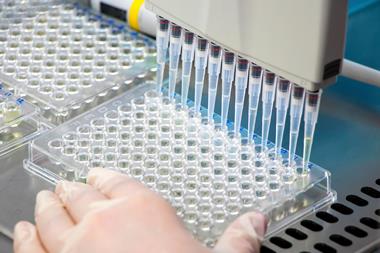UK will no longer allow Reach-required animal tests intended to prove worker safety
The UK has taken another step away from EU policy by re-enforcing a ban on animal testing for ingredients used exclusively in cosmetics. Such tests can be permitted under EU regulations, but only when required to prove safety for manufacturing workers or the environment.
Secretary of state Suella Braverman informed the UK Parliament on 17 May that the government will no longer grant licences for animal testing of chemicals that are intended only to be used as ingredients in cosmetic products.

The move comes after animal rights group Cruelty Free International (CFI) challenged the government over allegedly hiding a policy change which led to the ‘weakening’ of the UK’s long-standing ban on animal testing of cosmetics ingredients.
In February 2019, the Home Office aligned UK policy with two controversial decisions by the European Chemicals Agency’s (Echa) board of appeal, the body that handles disputes over the agency’s decisions. Symrise, a cosmetics ingredient producer, had clashed with Echa over being asked to conduct animal testing for the registration of two cosmetics-only substances: homosalate and 2-ethylhexyl salicylate.
Marketing cosmetic products with ingredients that have been tested on animals is banned in the EU under the cosmetic products regulation. But the Echa board confirmed that under the registration, evaluation, authorisation and restriction of chemicals (Reach) regulations, substances that are used solely in cosmetics may sometimes be tested on animals, as a last resort, to prove their safety for workers or the environment.
According to Braverman, the UK’s alignment with this ‘has been reflected in the issuing of a small number of time-limited licences’ for animal testing under UK Reach between 2019 and 2022. The decision to stop issuing licenses comes despite the UK high court dismissing CFI’s challenge. In a ruling on 5 May, the judge said it was ‘regrettable’ the government did not publicly announce a change in policy, but overall there were no breaches of legal duties.
Under the UK’s new rules, companies will still have to follow the same data requirements as under EU Reach. However, the government will no longer issue licences for animal testing, as Echa does in the EU.
Divergence
The UK’s quick implementation of a new policy comes in stark contrast to a long and inconclusive debate in the EU. However, it raises questions about how the policy will be implemented.
The dispute over animal testing of cosmetic ingredients under EU Reach has a long history, spanning several court cases and public disputes. In May, members of the European parliament discussed the issue after a European citizen’s initiative (ECI), ‘Save Cruelty Free Cosmetics’, received more than the one million signatures required to be formally considered by the European commission.
CFI, which was one of the groups that launched the petition, said the ECI is essentially asking for an EU-wide implementation of the animal testing policy that was in place in the UK from 1998 to 2019. ‘We want to see a commitment to ending tests on animals conducted for any purpose for all cosmetics substances,’ said CFI’s director of science and regulatory affairs, Emma Grange.
It is essential that both industry and regulators can confidently use, assess and interpret [non-animal tests] for ensuring chemical safety
Animal rights groups hope the UK policy might influence an ongoing dispute at the European court of justice against Echa’s decisions from 2019, which questions whether animal testing of cosmetics-only substances under Reach is compatible with the EU cosmetics regulation’s animal testing ban. While Grange is hesitant to comment on how likely the UK move is to affect the outcome of that dispute, she says that ‘the UK’s partial reinstatement of the ban on animal testing for cosmetics is a step in the right direction, which the EU should follow’.
Humane Society International (HSI) agreed the UK’s decision could serve as a precedent for the EU to follow suit. ’Echa’s use of Reach information requirements to justify tests on animals (…) is a clear illustration of the problems created by the Reach “tick-box” approach to toxicology, rooted in inflexible animal data requirements rather than real-world chemical safety,’ said Donna Macmillan, HSI senior strategist, regulatory science.
Echa, which has often come under fire for requesting in vivo testing for cosmetics-only ingredients under Reach, has been increasingly active in promoting the uptake of alternative test methods.
The agency held its first new approach methodologies (NAMs) workshop on 31 May–1 June, focused on speeding up the transition to an animal-free regulatory system. Published in the same week, Echa’s latest analysis of alternative testing methods, which it submits to the European commission every three years, recorded a steadily positive trend towards in vitro studies.
The UK cosmetic, toiletry and perfumery association (CTPA) welcomed both the UK’s policy, and Echa’s efforts, as steps in the right direction. ‘We hope to see regulatory environments in the UK and EU which are harmonised in their adoption and acceptance of NAM approaches,’ the trade body told Chemistry World.
For now, the UK will have to carefully implement the animal testing ban under its national Reach framework, CTPA said. ’The UK government is working on a new registration model for UK Reach, and the cosmetics industry is working closely with the government to advocate for non-animal safety assessment methods to be enshrined within the framework.
‘For chemicals exclusively used as cosmetic ingredients, it is essential that both industry and regulators can confidently use, assess and interpret NAM approaches for ensuring chemical safety,’ CTPA said.












No comments yet